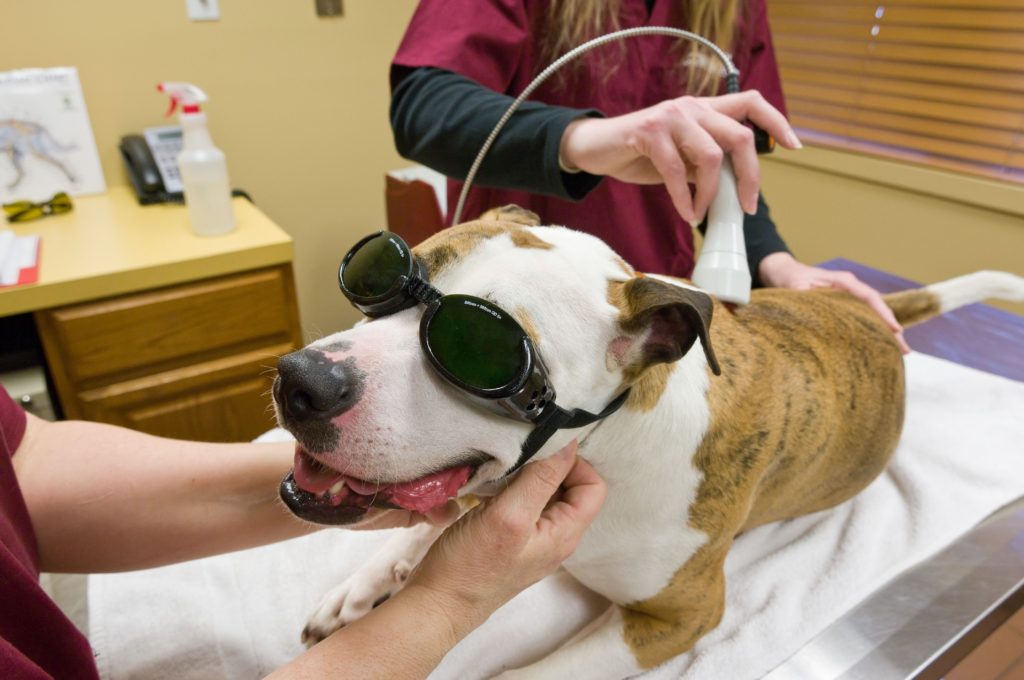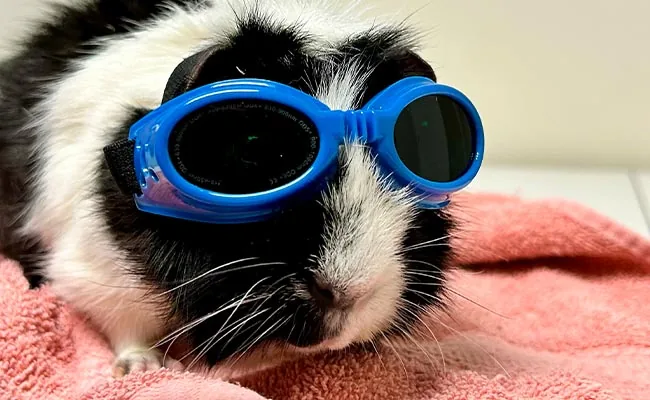Laser Veterinary

Veterinary medicine is undergoing a transformative journey with the integration of cutting-edge technologies to enhance treatment outcomes and elevate the standard of care for our beloved pets. Among these innovations, the use of veterinary lasers in veterinary therapy and surgery has emerged as a revolutionary advancement, with Eclipse®-VLS leading the way for both large and small animals.
How Does Veterinary Laser Therapy Work?
- Photothermal effect refers to the phenomenon where light is absorbed by a tissue, leading to an increase in its temperature. In the context of laser therapy, the photothermal effect plays a crucial role in various applications, including acceleration of cellular metabolism and blood flow. Higher temperatures can induce coagulation, which is the process of blood clotting. This can be beneficial in procedures where sealing blood vessels is required, such as wound treatment, and/or in laser surgery.
- Photochemical effect, a.k.a. photobiomodulation (PBM) occurs when laser light penetrates tissues and is absorbed by cells. The primary mechanism involves photon interaction with cytochrome c oxidase (CCO), boosting adenosine triphosphate (ATP) production and oxygen consumption. This process can alter nitric oxide (NO) levels, activate secondary messenger pathways, transcription factors, and stimulate growth factor production. These effects enhance cellular metabolism, promote cell proliferation, reduce inflammation, accelerate healing, and provide pain relief through endorphin release.
- Photophysical effects on the body are mainly concentrate on the effect of light on propagation of electrical signals through neural network; and on exciting vibrations in proteins and subcellular structures. In-vitro studies of neurons demonstrated that light can induce axonal varicosities in the same way as pharmacological anesthetics, resulting in the blockade of neurotransmission and therefore producing an analgesic effect. Light can also excite vibrations in proteins, which in turn enable proteins to change shape quickly so they can readily bind to other proteins, a process that is necessary for the body to perform critical biological functions like absorbing oxygen, repairing cells and replicating DNA.
Pain Management:
- Laser therapy provides a modern, drug-free, and painless alternative to manage pain associated with various conditions such as arthritis, musculoskeletal injuries, and post-surgical discomfort.
- It has analgesic effects by reducing inflammation and promoting the release of endorphins, the body’s natural painkillers.
- For chronic conditions such as osteoarthritis, laser therapy can be part of a long-term pain management plan to improve the quality of life for affected animals.
Anti-Inflammatory Effects:
- Laser therapy helps to reduce inflammation by modulating the inflammatory response at the cellular level.
- The anti-inflammatory properties of light can be beneficial in treating a wide spectrum of disorders – from otitis and upper respiratory conditions to urinary tract and perianal conditions.
Wound Healing:
- Laser therapy accelerates the healing process of wounds and incisions by promoting tissue repair and regeneration.
- It can be used in post-surgical care to minimize scarring and improve overall recovery.
Musculoskeletal Conditions:
- In small animals, laser therapy is often employed to treat musculoskeletal issues such as arthritis, hip dysplasia, and intervertebral disc disease.
- The therapy helps to improve joint mobility, reduce pain, and enhance overall function.
Dermatological Conditions:
- Laser therapy helps to reduce inflammation by modulating the inflammatory response at the cellular level.
- The anti-inflammatory properties of light can be beneficial in treating a wide spectrum of disorders – from otitis and upper respiratory conditions to urinary tract and perianal conditions.
Acupuncture Alternative:
- Laser therapy is sometimes used as an alternative or complementary treatment to acupuncture, providing similar benefits without the use of needles.
It’s important for veterinary practitioners to tailor laser therapy protocols to the specific needs of each patient, considering factors such as the condition being treated, the animal’s size and coat thickness, and the desired therapeutic outcomes. Additionally, safety measures, including the use of protective eyewear for both the patient and the handler, should be implemented during laser therapy sessions.
Apart from therapeutic uses, lasers also play an instrumental role in veterinary surgery. Veterinary laser surgery offers a high degree of precision, reduces bleeding, and minimizes pain during procedures. The result is quicker recovery times and less postoperative discomfort for the animal.
Veterinary laser surgery has become an integral part of modern veterinary practice, offering numerous advantages that can elevate surgical outcomes. Here are some ways in which laser surgery contributes to improved results in veterinary procedures:
- Precision and Control: Laser surgery provides precise control over the cutting and ablation process. It is compatible with endoscopes, thus replacing formerly debilitating procedures requiring hospitalization with minimaly invasive surgery. This is particularly beneficial in delicate procedures or when working in sensitive areas. The laser beam seals small blood vessels and nerve endings as it cuts, providing a clearer surgical field and improved clear operating field for the surgeon. Laser surgery is particularly advantageous in the removal of tumors, allowing for precise removal of abnormal tissues while minimizing damage to healthy surrounding structures.
- Reduced Risk of Infection: The non-contact nature of theprocedure, along with the high temperatures generated by the laser beam during surgery help keeping the incision site sterile, reducing the risk of postoperative infections.
- Decreased Swelling and Inflammation: Laser light has anti-inflammatory effects. The reduced trauma, swelling and inflammation associated with laser surgery contribute to improved postoperative comfort for animals.
- Quicker Recovery: With reduced bleeding, swelling, and tissue damage, animals often experience faster recovery times after laser surgery compared to conventional procedures. Laser energy stimulates cellular activity and promotes tissue healing, contributing to a smoother and accelerated healing process.
- Reduced Need for Anesthesia: Some laser procedures can be performed with less anesthesia compared to traditional surgery, which may be advantageous, especially for older or high-risk patients.
It’s important for veterinary surgeons to receive proper training in laser surgery techniques and safety protocols. Additionally, a thorough understanding of the specific advantages and considerations for different types of lasers is crucial for achieving optimal outcomes. While laser surgery offers numerous benefits, its application should be tailored to individual cases and surgical requirements.
At the heart of technological breakthroughs in laser veterinary equipment stands Eclipse® – VLS. Designed with state-of-the-art technology, Eclipse® – VLS delivers a versatile, reliable, and efficient solution for your veterinary laser needs.
OmniLase’s Eclipse® – VLS system is the most sophisticated veterinary laser in the market. It is an all-in-one therapeutic and surgery multi-wavelengths system with pre-set treatment protocols that take any guesswork out of pre-surgical, post-surgical, acute, and chronic disease state procedures.
The Eclipse® – VLS includes:
- Up to 4 wavelengths
- Enhanced photobiomodulation treatment protocols
- 36 Watts output power
- Clinically proven species-specific preloaded Protocols for canine, feline, equine, and exotic patients
- Manual Operation, for the expert user
- Battery operation
- Rugged aluminum housing
- Armored fiber-optic cable
- Intuitive User Interface through touch-screen display
Harness the potential of Eclipse® – VLS and redefine the care you provide to your animals. Together, we can pave the way for a new era in veterinary medicine where pain and discomfort are minimized, and recovery is swift. Trust in Eclipse® – VLS to guide you through this journey, providing innovative solutions for the ever-changing demands of animal care.
Veterinary Lasers Add Revenue to Your Practice
It is not a secret that sometimes a valuable piece of equipment does not find its way to veterinary clinics because of a poor return on investment. This is not the case of veterinary laser. Investing in a veterinary laser equipment proves to be a sound financial decision for veterinary clinics. The return on investment is substantial, with a three-doctor practice generating an additional $40K-80K in revenue from offering laser treatments, often paying back the capital investment in less than a year. Semiconductor laser diode systems require minimal maintenance and no consumables, ensuring longevity and cost-effectiveness.



